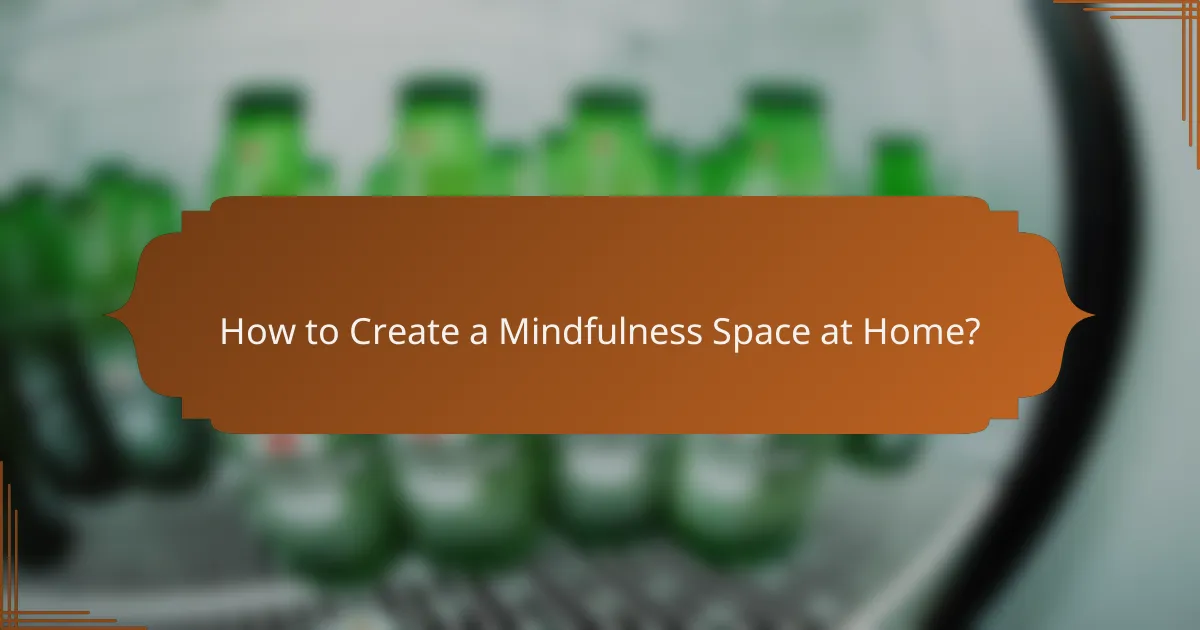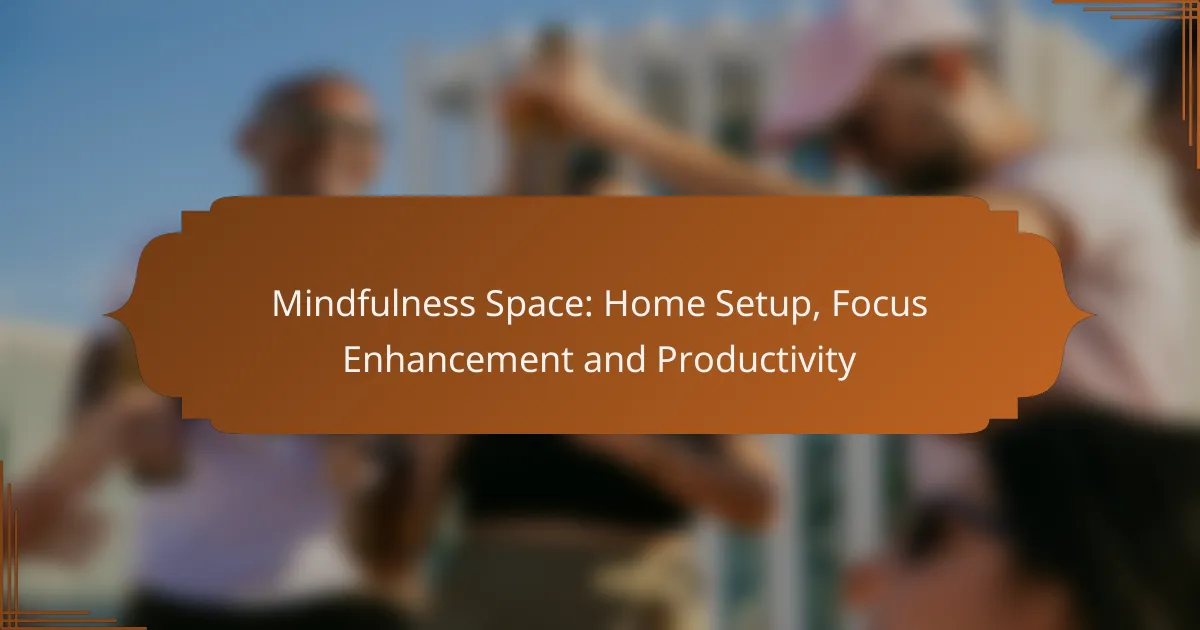Creating a mindfulness space at home is essential for enhancing focus and productivity. By designating a distraction-free area for relaxation and mindfulness practices, you can cultivate an environment that promotes mental clarity and emotional well-being. Integrating tools and techniques that streamline tasks and enhance awareness will further support your journey towards greater concentration and efficiency.

How to Create a Mindfulness Space at Home?
Creating a mindfulness space at home involves setting aside a specific area designed for relaxation and focus. This space should be free from distractions and conducive to practices like meditation, reading, or simply unwinding.
Designated quiet area
A designated quiet area is essential for fostering mindfulness. Choose a spot in your home that is away from high-traffic zones and noise. This could be a corner of a room or even a separate room dedicated to mindfulness activities.
Ensure that this area is comfortable and inviting, perhaps by adding a soft rug or cushions. The goal is to create a space where you can retreat and focus without interruptions.
Comfortable seating options
Comfortable seating is crucial for a mindfulness space, as it encourages longer periods of relaxation and focus. Consider options like meditation cushions, bean bags, or ergonomic chairs that support good posture.
When selecting seating, prioritize materials that are soft and inviting. You might also want to add blankets or throws for extra comfort during your mindfulness sessions.
Natural lighting considerations
Natural lighting plays a significant role in creating a calming environment. Aim to position your mindfulness space near windows to take advantage of daylight, which can enhance mood and focus.
If natural light is limited, consider using soft, warm artificial lighting to mimic the effects of sunlight. Avoid harsh fluorescent lights, as they can be distracting and uninviting.
Incorporating plants
Incorporating plants into your mindfulness space can enhance the atmosphere and improve air quality. Choose low-maintenance plants like succulents or peace lilies that thrive indoors and require minimal care.
Plants not only add a touch of nature but also promote a sense of tranquility. Position them strategically around your space to create a calming visual effect.
Personalized decor elements
Personalized decor elements can make your mindfulness space feel unique and inviting. Consider adding items that resonate with you, such as artwork, inspirational quotes, or meaningful objects.
Keep the decor simple and uncluttered to maintain a serene environment. Use colors and textures that evoke calmness, such as soft blues, greens, or earthy tones.

What Tools Enhance Focus and Productivity?
Tools that enhance focus and productivity include various applications and devices designed to minimize distractions and streamline tasks. By integrating these tools into your daily routine, you can create an environment that fosters concentration and efficiency.
Meditation apps like Headspace
Meditation apps such as Headspace offer guided sessions that help users cultivate mindfulness and reduce stress, which can significantly improve focus. These apps typically provide a range of meditation styles, from short sessions for beginners to longer practices for advanced users.
Consider setting aside a few minutes each day to use these apps. Regular practice can lead to better emotional regulation and increased attention span, making it easier to concentrate on tasks.
Noise-canceling headphones
Noise-canceling headphones are effective tools for blocking out distracting sounds, allowing for deeper focus on work or study. They are particularly beneficial in open office environments or busy households where background noise can disrupt concentration.
When selecting noise-canceling headphones, look for models that offer adjustable levels of noise cancellation. This feature allows you to customize your listening experience based on your environment, enhancing productivity without sacrificing awareness of your surroundings.
Focus-enhancing playlists
Focus-enhancing playlists consist of music or ambient sounds specifically designed to improve concentration. These playlists often feature instrumental tracks or nature sounds that minimize distractions and create a calming atmosphere.
Platforms like Spotify and YouTube offer a variety of curated playlists for focus. Experiment with different genres to find what works best for you, as personal preferences can significantly impact productivity levels.
Time management tools like Trello
Time management tools such as Trello help organize tasks and projects visually, making it easier to prioritize and track progress. These tools typically use boards, lists, and cards to facilitate workflow and collaboration.
To maximize productivity with Trello, create boards for different projects and set deadlines for each task. Regularly reviewing your boards can help maintain focus and ensure that you stay on track with your goals.

How to Optimize Your Mindfulness Routine?
To optimize your mindfulness routine, focus on integrating daily practices that enhance awareness and presence. Consistency and variety in techniques can significantly improve your mental clarity and emotional well-being.
Daily meditation practices
Daily meditation practices can vary in duration and style, but aim for at least 10-20 minutes each day. Techniques such as guided meditation, body scans, or loving-kindness meditation can help you cultivate a deeper sense of mindfulness.
Consider using apps or online resources to find guided sessions that suit your preferences. Establishing a specific time and quiet space for meditation can reinforce your commitment and make it easier to stick to your routine.
Mindfulness journaling techniques
Mindfulness journaling involves writing down thoughts, feelings, and experiences to enhance self-awareness. Set aside time each day to reflect on your emotions and observations, which can help clarify your thoughts and reduce stress.
Try prompts like “What am I grateful for today?” or “What emotions did I experience?” to guide your writing. Keeping your journal private encourages honesty and can lead to deeper insights over time.
Breathing exercises
Breathing exercises are effective tools for grounding yourself in the present moment. Techniques such as deep belly breathing or the 4-7-8 method can reduce anxiety and promote relaxation.
Practice inhaling deeply for four counts, holding for seven, and exhaling for eight. Repeat this cycle several times to calm your mind and body, especially during stressful situations.
Setting achievable goals
Setting achievable goals is crucial for maintaining motivation in your mindfulness practice. Start with small, specific objectives, such as meditating three times a week or journaling for five minutes daily.
As you progress, gradually increase the complexity or frequency of your goals. Regularly review your achievements to celebrate your growth and adjust your goals as needed to keep your practice engaging and rewarding.

What Are the Benefits of a Mindfulness Space?
A mindfulness space offers numerous benefits, including stress reduction, enhanced focus, and increased creativity. By creating a dedicated area for mindfulness practices, individuals can cultivate a more productive and balanced lifestyle.
Reduced stress levels
A mindfulness space helps lower stress levels by providing a tranquil environment where individuals can practice relaxation techniques. Engaging in mindfulness activities, such as meditation or deep breathing, can significantly decrease cortisol levels, the hormone associated with stress.
To maximize stress reduction, consider incorporating elements like soft lighting, calming scents, and comfortable seating. Regular use of this space for just a few minutes each day can lead to noticeable improvements in overall well-being.
Improved concentration
Creating a mindfulness space can lead to improved concentration by minimizing distractions and fostering a focused mindset. When individuals dedicate a specific area for mindfulness, they signal to their brain that it is time to engage in focused activities.
To enhance concentration, ensure your mindfulness space is free from clutter and noise. Techniques such as mindfulness meditation can train the mind to maintain focus, potentially increasing productivity in other areas of life.
Enhanced creativity
A mindfulness space can boost creativity by allowing the mind to relax and wander freely. This relaxed state often leads to new ideas and innovative solutions, as the brain is not constrained by the pressures of daily tasks.
Incorporate inspiring visuals, such as artwork or nature scenes, into your mindfulness space to stimulate creative thinking. Regularly spending time in this environment can help unlock creative potential and encourage out-of-the-box thinking.
